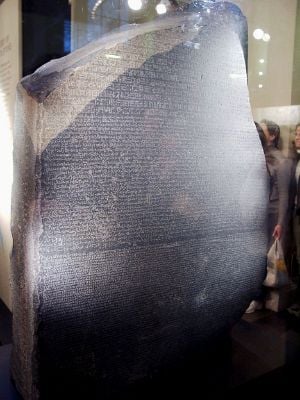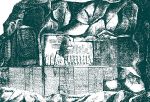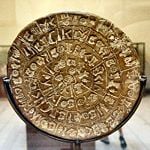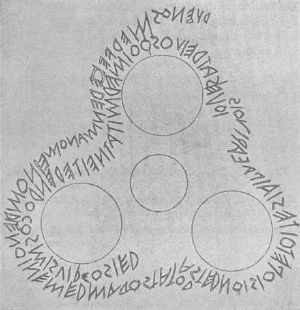Difference between revisions of "Epigraphy" - New World Encyclopedia
({{Contracted}}) |
Nick Perez (talk | contribs) |
||
| Line 24: | Line 24: | ||
==Notable inscriptions== | ==Notable inscriptions== | ||
| − | + | ||
| − | + | ===[[Rosetta Stone]]=== | |
| − | + | The Rosetta Stone is an ancient stele inscribed with the same passage of writing in two Egyptian language scripts and in classical Greek. It was created in 196 B.C.E., discovered by the French in 1799, and translated in 1822 by the Frenchman Jean-François Champollion. The Rosetta Stone was inscribed with three scripts so that it could be read not only by the local populace, but also by visiting priests and government officials. The first script was Egyptian hieroglyphs, the script used for religious documents and other important communications. The second was Demotic Egyptian, which was the common script of Egypt. The third was Greek, which was the language of the court. | |
| − | + | ||
| − | + | The stone displays the same Ptolemaic decree of 196 B.C.E. in all three scripts. The Greek script of the Rosetta Stone begins: Basileuontos tou neou kai paralabontos tēn basileian para tou patros… (Greek: Βασιλεύοντος του νέου και παραλαβόντος την βασιλείαν παρά του πατρός…), or “The new king, having received the kingship from his father….” It is a decree from Ptolemy V, describing various taxes he repealed (one measured in ardebs (Greek artabai) per aroura), and instructing that statues be erected in temples and that the decree be published in the writing of the words of gods (hieroglyphs), the writing of the people (demotic), and the Wynen (Greek; the word is cognate with Ionian) language. | |
| − | + | ||
| − | + | ===[[Behistun Inscription]]=== | |
| − | + | [[Image:BehistunInscriptionSketch.jpg|thumb|150px|Behistun Inscription, with some modern annotations Sketch: Fr. Spiegel, Die altpers. Keilinschriften, Leipzig 1881]] | |
| − | + | The Behistun Inscription (also Bisitun or Bisutun, بیستون in modern Persian; in Old Persian is Bagastana the meaning is "the god's place or land") is to cuneiform what the Rosetta Stone is to Egyptian hieroglyphs: the document most crucial in the decipherment of a previously lost script. It is located in the Kermanshah Province of Iran, and contains three versions of the same text, written in three different cuneiform script languages: Old Persian, Elamite, and Babylonian. Successive work by Georg Friedrich Grotefend, Henry Rawlinson, and others resulted in translation of the text by the mid-nineteenth century. This enabled many other cuneiform texts, preserved but undeciphered for centuries, to be translated revealing much about the most ancient civilizations of human history. This is a significant step in the advancement of human knowledge and the understanding of ourselves and our past, and serves as an essential foundation for a better future. | |
| − | + | ||
| − | + | ===[[Decree of Themistocles]]=== | |
| − | + | [[Image:EPMA-13330-Themistocle decree-2.JPG|thumb|right|Decree of Themistocles, NAMA, 13330]] | |
| − | + | The '''Decree of Themistocles''' is an [[ancient Greek]] inscription discussing Greek strategy in the [[Greco-Persian Wars]], purported to have been issued by the [[Athens|Athenian]] assembly under the guidance of [[Themistocles]]. Since the publication of its contents in 1960, the authenticity of the decree has been the subject of much academic debate. The decree directly contradicts [[Herodotus]]'s account of the evacuation of Attica in [[480 B.C.E.]], in which it is stated that the evacuation was an emergency measure taken only after the [[Peloponnese|Peloponnesian]] army failed to advance into [[Boeotia]] to fight the Persians. If the decree is authentic, the abandonment of Attica was part of a considered strategy aiming to draw the Persians into naval combat at [[Artemisium]] or [[Salamis Island|Salamis]]. | |
| − | + | ||
| − | + | ===[[Dipylon inscription]]=== | |
| − | + | The '''Dipylon inscription''' is a short text written on an ancient Greek pottery vessel dated to c.740 B.C.E. It is famous for being the oldest (or one of the oldest) known samples of the use of the [[Greek alphabet]]. | |
| + | |||
| + | The text is scratched on a wine jug ([[oenochoe]]), which was found in 1871 and is named after the location where it was found, the ancient [[Dipylon]] Cemetery, near the Dipylon Gate on the area of [[Kerameikos]] in [[Athens]]. The text is written in an archaic form of the Greek alphabet, with some letter shapes still resembling those of the original [[Phoenician alphabet]]. It is written from right to left, with the individual letters mirror-shaped in comparison with the modern forms. It is placed in a circle around the shoulder of the vessel. | ||
| + | |||
| + | ===[[Laguna Copperplate Inscription]]=== | ||
| + | [[Image:lci.gif|right|thumb|150px|Laguna Copperplate Insciprtion (circa [[900|900 C.E.]]) shows heavy Indian cultural influence present in the Philippines during the era previous to Spanish colonization in the 16th century]] | ||
| + | The '''Laguna Copperplate inscription''' (also shortened to '''LCI'''), found [[1989]] in [[Laguna de Bay]], in the metroplex of [[Manila, Philippines]], has inscribed on it a date of [[Saka era]] 822, corresponding to [[April 21]], [[900]] CE according to [[Indian astronomy|Vedic astronomy]], containing words from [[Sanskrit]], old [[Javanese]], old [[Malay language|Malay]] and old [[Tagalog language|Tagalog]], releasing its bearer, Namwaran, from a debt in [[gold]]. The document mentions the places of [[Tondo]], [[Pila, Laguna|Pila]] and [[Pulilan]] in the area around [[Manila Bay]] and [[Medan]], [[Indonesia]]. It shows the strong links present between the [[Tagalog language|Tagalog]] speaking people of this time and the various contemporary civilizations in Asia, most notably the [[Middle kingdoms of India]] and the [[Srivijaya]] empire of [[Java]]. | ||
| + | |||
| + | The Laguna Copperplate Inscription, among other discoveries made in recent years in the country such as the [[Golden Tara]] of [[Butuan]] and 14th century pottery and gold jewellery artifacts found in [[Cebu]], is highly important in revising the ancient history of the [[Philippine]] archipelago (which prior to the LCI discovery was considered by western historians to be culturally isolated from the rest of Asia, as no evident pre-hispanic written records were found at the time). It sheds light on the ancient [[History of the Philippines|Philippine history]], which was previously largely ignored due to the dominantly Hispanic-derived culture present during the Spanish occupation. This document is considered a [[National treasure]] and rests in the [[National Museum of the Philippines]] in [[Manila]]. | ||
| + | |||
| + | ===[[Malia altar stone]]=== | ||
| + | The '''Malia altar stone''' is a stone slab bearing an inscription in [[Cretan hieroglyphs]], excavated in [[Malia (city)|Malia]], [[Crete]]. The stone has a cuplike cavity and is thought to be a [[Minoan]] [[altar stone]]. Of the 16 glyphs of the inscription, three occur twice each. The inscription is the only known instance of Cretan hieroglyphs on stone. | ||
| + | |||
| + | ===[[Phaistos Disc]]=== | ||
| + | [[Image:Diskos.von.Phaistos Seite.A 11-Aug-2004 asb PICT3371.JPG|thumb|left|150px|]] | ||
| + | The '''Phaistos Disc''' ('''Phaistos Disk''', '''Phaestos Disc''') is a curious archaeological find, likely dating to the middle or late [[Minoan]] [[Bronze Age]]. Its purpose and meaning, and even its original geographical place of manufacture, remain disputed, making it one of the most famous mysteries of [[archaeology]]. This unique object is now on display at the [[Iraklion Archaeological Museum|archaeological museum]] of [[Herakleion]] in [[Crete]], [[Greece]]. | ||
| + | |||
| + | ===[[Duenos Inscription]]=== | ||
| + | [[Image:Duenos inscription.jpg|thumb|right|The Duenos inscription, as recorded by [[Heinrich Dressel]].]] | ||
| + | The '''Duenos Inscription''' is one of the earliest known [[Old Latin]] texts, dating from circa the [[6th century B.C.E.]]. It is inscribed on the sides of a ''[[kernos]]'', or set of vases joined together with clay, found by [[Heinrich Dressel]] in 1880 on the [[Quirinal Hill]] in [[Rome]]. The ''kernos'' was in the [[Staatliche Museen]] in [[Berlin]] (inventory no. 30894,3), prior to the reunification of [[Germany]] and the reorganization of the national museums in that city. | ||
| + | |||
| + | The inscription is difficult to translate, as some letters are hard to distinguish, particularly since they are in [[Old Latin]]. To further complicate the matter, there are no spaces between the letters, so even deciphering which letters belong to which words is a difficult task. | ||
| + | |||
| + | ===[[Bitola inscription]]=== | ||
| + | [[Image:Bitola Inscription.jpg|thumb|right|200px|<center>The Bitola Inscription of Tsar Ivan Vladislav, restored copy. <br />National History Museum of Bulgaria</center>]] | ||
| + | |||
| + | The '''Bitola inscription''' is a medieval stone inscription written in [[Old Church Slavonic|Old Bulgarian]]. It was found in 1956 during the demolition of an old Ottoman mosque in the town of [[Bitola]], [[Republic of Macedonia]] and it is now kept at the Institute and Museum of Bitola. The text commemorates the fortification works on the fortress of Bitola under one [[Tsar]] Ivan. It is believed to date from c.1015, in which case the monarch in question would be Tsar [[Ivan Vladislav of Bulgaria]], According to some scholars, the stone is from the 13th century, in which case it would be Tsar [[Ivan Asen]] of Bulgaria.<ref name="Lunt1">Lunt, Horace (1982): On dating Old Church Slavonic bible manuscripts. In: A. A. Barentsen, M. G. M. Tielemans, R. Sprenger (eds.), ''South Slavic and Balkan linguistics''. Rodopi. p.230.</ref><ref>Mathiesen R. (1977): The Importance of the Bitola Inscription for Cyrilic Paleography. ''The Slavic and East European Journal'' 21: 1-2.</ref> | ||
==Types of inscription== | ==Types of inscription== | ||
Revision as of 18:31, 18 September 2007
Epigraphy (Greek, επιγραφή—"written upon") is the study of inscriptions or epigraphs engraved into stone or other durable materials, or cast in metal, the science of classifying them as to cultural context and date, elucidating them and assessing what conclusions can be deduced from them. A person studying this is called an epigrapher or epigraphist.
Scope
Epigraphy is a primary tool of archaeology when dealing with literate cultures. The US Library of Congress classifies epigraphy as one of the "Auxiliary Sciences of History". Epigraphy also helps identify a forgery: epigraphic evidence formed part of the discussion concerning the James Ossuary. Since epigraphy is a science of the particular, references to epigraphic evidence appear in most Wikipedia entries discussing aspects of Ancient history.
The study of ancient handwriting, usually in ink, is a separate field, Paleography.
The character of the writing, the subject of epigraphy, is a matter quite separate from the nature of the text, which is studied in itself. Texts inscribed in stone are usually for public view (or for the view of the god, as in the Persian Behistun inscription), and so they are essentially different from the written texts of each culture. Not all inscribed texts are public, however: in Mycenean culture the deciphered texts of "Linear B" were revealed to be largely used for economic and administrative record keeping. Informal inscribed texts are "graffiti" in its original sense.
History
The science of epigraphy has been developing steadily since the 16th century. Principles of epigraphy vary culture by culture, and the infant science in European hands concentrated on Latin inscriptions at first. Individual contributions have been made by epigraphers such as Georg Fabricius (1516–1571); August Wilhelm Zumpt (1815–1877); Theodor Mommsen (1817–1903); Emil Hübner (1834–1901); Franz Cumont (1868–1947); Louis Robert (1904–1985).
The Corpus Inscriptionum Latinarum, begun by Mommsen and other scholars, has been published in Berlin since 1863, with wartime interruptions. It is the largest and most extensive collection of Latin inscriptions. New fascicles are still produced as the recovery of inscriptions continues. The Corpus is arranged geographically: all inscriptions from Rome are contained in volume 6. This volume has the greatest number of inscriptions; volume 6, part 8, fascicle 3 was just recently published (2000). Specialists depend on such on-going series of volumes in which newly-discovered inscriptions are published, often in Latin, not unlike the biologists' Zoological Record—the raw material of history.
Greek epigraphy has unfolded in the hands of a different team, with different corpora. There are two. The first is Corpus Inscriptionum Graecarum of which four volumes came out, again at Berlin, 1825-1877. This marked a first attempt at a comprehensive publication of Greek inscriptions copied from all over the Greek-speaking world. Only advanced students still consult it, for better editions of the texts have superseded it. The second, modern corpus is Inscriptiones Graecae arranged geographically under categories: decrees, catalogues, honorary titles, funeral inscriptions, various., all presented in Latin, to preserve the international neutrality of the field of classics.
Other such series include the Corpus Inscriptionum Etruscarum (Etruscan inscriptions), Corpus Inscriptionum Crucesignatorum Terrae Sanctae (Crusaders' inscriptions), Corpus Inscriptionum Insularum Celticarum, (Celtic inscriptions), Corpus Inscriptionum Iranicarum (Iranian inscriptions) and so forth.
Notable inscriptions
Rosetta Stone
The Rosetta Stone is an ancient stele inscribed with the same passage of writing in two Egyptian language scripts and in classical Greek. It was created in 196 B.C.E., discovered by the French in 1799, and translated in 1822 by the Frenchman Jean-François Champollion. The Rosetta Stone was inscribed with three scripts so that it could be read not only by the local populace, but also by visiting priests and government officials. The first script was Egyptian hieroglyphs, the script used for religious documents and other important communications. The second was Demotic Egyptian, which was the common script of Egypt. The third was Greek, which was the language of the court.
The stone displays the same Ptolemaic decree of 196 B.C.E. in all three scripts. The Greek script of the Rosetta Stone begins: Basileuontos tou neou kai paralabontos tēn basileian para tou patros… (Greek: Βασιλεύοντος του νέου και παραλαβόντος την βασιλείαν παρά του πατρός…), or “The new king, having received the kingship from his father….” It is a decree from Ptolemy V, describing various taxes he repealed (one measured in ardebs (Greek artabai) per aroura), and instructing that statues be erected in temples and that the decree be published in the writing of the words of gods (hieroglyphs), the writing of the people (demotic), and the Wynen (Greek; the word is cognate with Ionian) language.
Behistun Inscription
The Behistun Inscription (also Bisitun or Bisutun, بیستون in modern Persian; in Old Persian is Bagastana the meaning is "the god's place or land") is to cuneiform what the Rosetta Stone is to Egyptian hieroglyphs: the document most crucial in the decipherment of a previously lost script. It is located in the Kermanshah Province of Iran, and contains three versions of the same text, written in three different cuneiform script languages: Old Persian, Elamite, and Babylonian. Successive work by Georg Friedrich Grotefend, Henry Rawlinson, and others resulted in translation of the text by the mid-nineteenth century. This enabled many other cuneiform texts, preserved but undeciphered for centuries, to be translated revealing much about the most ancient civilizations of human history. This is a significant step in the advancement of human knowledge and the understanding of ourselves and our past, and serves as an essential foundation for a better future.
Decree of Themistocles
The Decree of Themistocles is an ancient Greek inscription discussing Greek strategy in the Greco-Persian Wars, purported to have been issued by the Athenian assembly under the guidance of Themistocles. Since the publication of its contents in 1960, the authenticity of the decree has been the subject of much academic debate. The decree directly contradicts Herodotus's account of the evacuation of Attica in 480 B.C.E., in which it is stated that the evacuation was an emergency measure taken only after the Peloponnesian army failed to advance into Boeotia to fight the Persians. If the decree is authentic, the abandonment of Attica was part of a considered strategy aiming to draw the Persians into naval combat at Artemisium or Salamis.
Dipylon inscription
The Dipylon inscription is a short text written on an ancient Greek pottery vessel dated to c.740 B.C.E. It is famous for being the oldest (or one of the oldest) known samples of the use of the Greek alphabet.
The text is scratched on a wine jug (oenochoe), which was found in 1871 and is named after the location where it was found, the ancient Dipylon Cemetery, near the Dipylon Gate on the area of Kerameikos in Athens. The text is written in an archaic form of the Greek alphabet, with some letter shapes still resembling those of the original Phoenician alphabet. It is written from right to left, with the individual letters mirror-shaped in comparison with the modern forms. It is placed in a circle around the shoulder of the vessel.
Laguna Copperplate Inscription
The Laguna Copperplate inscription (also shortened to LCI), found 1989 in Laguna de Bay, in the metroplex of Manila, Philippines, has inscribed on it a date of Saka era 822, corresponding to April 21, 900 C.E. according to Vedic astronomy, containing words from Sanskrit, old Javanese, old Malay and old Tagalog, releasing its bearer, Namwaran, from a debt in gold. The document mentions the places of Tondo, Pila and Pulilan in the area around Manila Bay and Medan, Indonesia. It shows the strong links present between the Tagalog speaking people of this time and the various contemporary civilizations in Asia, most notably the Middle kingdoms of India and the Srivijaya empire of Java.
The Laguna Copperplate Inscription, among other discoveries made in recent years in the country such as the Golden Tara of Butuan and 14th century pottery and gold jewellery artifacts found in Cebu, is highly important in revising the ancient history of the Philippine archipelago (which prior to the LCI discovery was considered by western historians to be culturally isolated from the rest of Asia, as no evident pre-hispanic written records were found at the time). It sheds light on the ancient Philippine history, which was previously largely ignored due to the dominantly Hispanic-derived culture present during the Spanish occupation. This document is considered a National treasure and rests in the National Museum of the Philippines in Manila.
Malia altar stone
The Malia altar stone is a stone slab bearing an inscription in Cretan hieroglyphs, excavated in Malia, Crete. The stone has a cuplike cavity and is thought to be a Minoan altar stone. Of the 16 glyphs of the inscription, three occur twice each. The inscription is the only known instance of Cretan hieroglyphs on stone.
Phaistos Disc
The Phaistos Disc (Phaistos Disk, Phaestos Disc) is a curious archaeological find, likely dating to the middle or late Minoan Bronze Age. Its purpose and meaning, and even its original geographical place of manufacture, remain disputed, making it one of the most famous mysteries of archaeology. This unique object is now on display at the archaeological museum of Herakleion in Crete, Greece.
Duenos Inscription
The Duenos Inscription is one of the earliest known Old Latin texts, dating from circa the 6th century B.C.E. It is inscribed on the sides of a kernos, or set of vases joined together with clay, found by Heinrich Dressel in 1880 on the Quirinal Hill in Rome. The kernos was in the Staatliche Museen in Berlin (inventory no. 30894,3), prior to the reunification of Germany and the reorganization of the national museums in that city.
The inscription is difficult to translate, as some letters are hard to distinguish, particularly since they are in Old Latin. To further complicate the matter, there are no spaces between the letters, so even deciphering which letters belong to which words is a difficult task.
Bitola inscription
National History Museum of Bulgaria
The Bitola inscription is a medieval stone inscription written in Old Bulgarian. It was found in 1956 during the demolition of an old Ottoman mosque in the town of Bitola, Republic of Macedonia and it is now kept at the Institute and Museum of Bitola. The text commemorates the fortification works on the fortress of Bitola under one Tsar Ivan. It is believed to date from c.1015, in which case the monarch in question would be Tsar Ivan Vladislav of Bulgaria, According to some scholars, the stone is from the 13th century, in which case it would be Tsar Ivan Asen of Bulgaria.[1][2]
Types of inscription
- Abecedarium
- Chronogram
- Epitaph on a headstone
- Ex libris
- Memento mori
- Monumental inscription
- Rune stone
- Hero stone
- Stoichedon
ReferencesISBN links support NWE through referral fees
- Budge, E. A. Wallis. 2004. The Sarcophagus of Anchnesraneferab Queen of Ahmes II King of Egypt. Kessinger Publishing. ISBN 1417947608
External links
- L'Association Internationale d'Épigraphie Grecque et Latine
- American Society for Greek and Latin Epigraphy
- Current Epigraphy (blog)
- Epigraphische Datenbank Heidelberg
- Centre for the Study of Ancient Documents, Oxford University
- Electronic Archives of Greek and Latin Epigraphy
- Searchable Greek Inscriptions
- Ubi Erat Lupa: Many epigraphic resources and searchable catalogues
- Onno van Nijf, "Introduction to Greek and Latin epigraphy: an absolute beginners' guide"
- Jean-Marie Lassère, Manuel d’épigraphie romaine. Paris: Picard, Antiquité-synthèses, 2007, 2 volumes, 1167 pages (second edition, first edition in 2005).
- Religious Epithet in Orissan Inscription - India
Credits
New World Encyclopedia writers and editors rewrote and completed the Wikipedia article in accordance with New World Encyclopedia standards. This article abides by terms of the Creative Commons CC-by-sa 3.0 License (CC-by-sa), which may be used and disseminated with proper attribution. Credit is due under the terms of this license that can reference both the New World Encyclopedia contributors and the selfless volunteer contributors of the Wikimedia Foundation. To cite this article click here for a list of acceptable citing formats.The history of earlier contributions by wikipedians is accessible to researchers here:
The history of this article since it was imported to New World Encyclopedia:
Note: Some restrictions may apply to use of individual images which are separately licensed.
- ↑ Lunt, Horace (1982): On dating Old Church Slavonic bible manuscripts. In: A. A. Barentsen, M. G. M. Tielemans, R. Sprenger (eds.), South Slavic and Balkan linguistics. Rodopi. p.230.
- ↑ Mathiesen R. (1977): The Importance of the Bitola Inscription for Cyrilic Paleography. The Slavic and East European Journal 21: 1-2.




